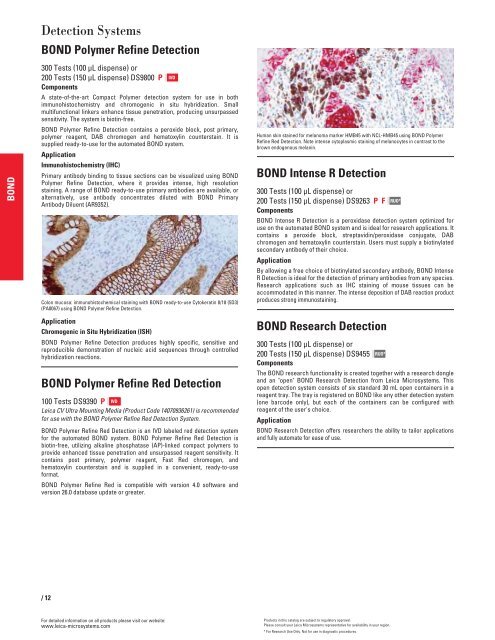QF0159 Marketing Release Record
QF0159 Marketing Release Record
QF0159 Marketing Release Record
You also want an ePaper? Increase the reach of your titles
YUMPU automatically turns print PDFs into web optimized ePapers that Google loves.
BOND<br />
Detection Systems<br />
BOND Polymer Refine Detection<br />
300 Tests (100 μL dispense) or<br />
200 Tests (150 μL dispense) DS9800 P<br />
Components<br />
A state-of-the-art Compact Polymer detection system for use in both<br />
immunohistochemistry and chromogenic in situ hybridization. Small<br />
multifunctional linkers enhance tissue penetration, producing unsurpassed<br />
sensitivity. The system is biotin-free.<br />
BOND Polymer Refine Detection contains a peroxide block, post primary,<br />
polymer reagent, DAB chromogen and hematoxylin counterstain. It is<br />
supplied ready-to-use for the automated BOND system.<br />
Application<br />
Immunohistochemistry (IHC)<br />
Primary antibody binding to tissue sections can be visualized using BOND<br />
Polymer Refine Detection, where it provides intense, high resolution<br />
staining. A range of BOND ready-to-use primary antibodies are available, or<br />
alternatively, use antibody concentrates diluted with BOND Primary<br />
Antibody Diluent (AR9352).<br />
Colon mucosa: immunohistochemical staining with BOND ready-to-use Cytokeratin 8/18 (5D3)<br />
(PA0067) using BOND Polymer Refine Detection.<br />
Application<br />
Chromogenic in Situ Hybridization (ISH)<br />
BOND Polymer Refine Detection produces highly specific, sensitive and<br />
reproducible demonstration of nucleic acid sequences through controlled<br />
hybridization reactions.<br />
BOND Polymer Refine Red Detection<br />
100 Tests DS9390 P<br />
Leica CV Ultra Mounting Media (Product Code 14070936261) is recommended<br />
for use with the BOND Polymer Refine Red Detection System.<br />
BOND Polymer Refine Red Detection is an IVD labeled red detection system<br />
for the automated BOND system. BOND Polymer Refine Red Detection is<br />
biotin-free, utilizing alkaline phosphatase (AP)-linked compact polymers to<br />
provide enhanced tissue penetration and unsurpassed reagent sensitivity. It<br />
contains post primary, polymer reagent, Fast Red chromogen, and<br />
hematoxylin counterstain and is supplied in a convenient, ready-to-use<br />
format.<br />
BOND Polymer Refine Red is compatible with version 4.0 software and<br />
version 26.0 database update or greater.<br />
/12<br />
IVD<br />
For detailed information on all products please visit our website:<br />
www.leica-microsystems.com<br />
IVD<br />
Human skin stained for melanoma marker HMB45 with NCL-HMB45 using BOND Polymer<br />
Refine Red Detection. Note intense cytoplasmic staining of melanocytes in contrast to the<br />
brown endogenous melanin.<br />
BOND Intense R Detection<br />
300 Tests (100 μL dispense) or<br />
200 Tests (150 μL dispense) DS9263 PF<br />
Components<br />
BOND Intense R Detection is a peroxidase detection system optimized for<br />
use on the automated BOND system and is ideal for research applications. It<br />
contains a peroxide block, streptavidin/peroxidase conjugate, DAB<br />
chromogen and hematoxylin counterstain. Users must supply a biotinylated<br />
secondary antibody of their choice.<br />
Application<br />
By allowing a free choice of biotinylated secondary antibody, BOND Intense<br />
R Detection is ideal for the detection of primary antibodies from any species.<br />
Research applications such as IHC staining of mouse tissues can be<br />
accommodated in this manner. The intense deposition of DAB reaction product<br />
produces strong immunostaining.<br />
BOND Research Detection<br />
300 Tests (100 μL dispense) or<br />
200 Tests (150 μL dispense) DS9455 RUO*<br />
Components<br />
The BOND research functionality is created together with a research dongle<br />
and an "open" BOND Research Detection from Leica Microsystems. This<br />
open detection system consists of six standard 30 mL open containers in a<br />
reagent tray. The tray is registered on BOND like any other detection system<br />
(one barcode only), but each of the containers can be configured with<br />
reagent of the user's choice.<br />
Application<br />
BOND Research Detection offers researchers the ability to tailor applications<br />
and fully automate for ease of use.<br />
Products in this catalog are subject to regulatory approval.<br />
Please consult your Leica Microsystems representative for availability in your region.<br />
* For Research Use Only. Not for use in diagnostic procedures.<br />
RUO*
















